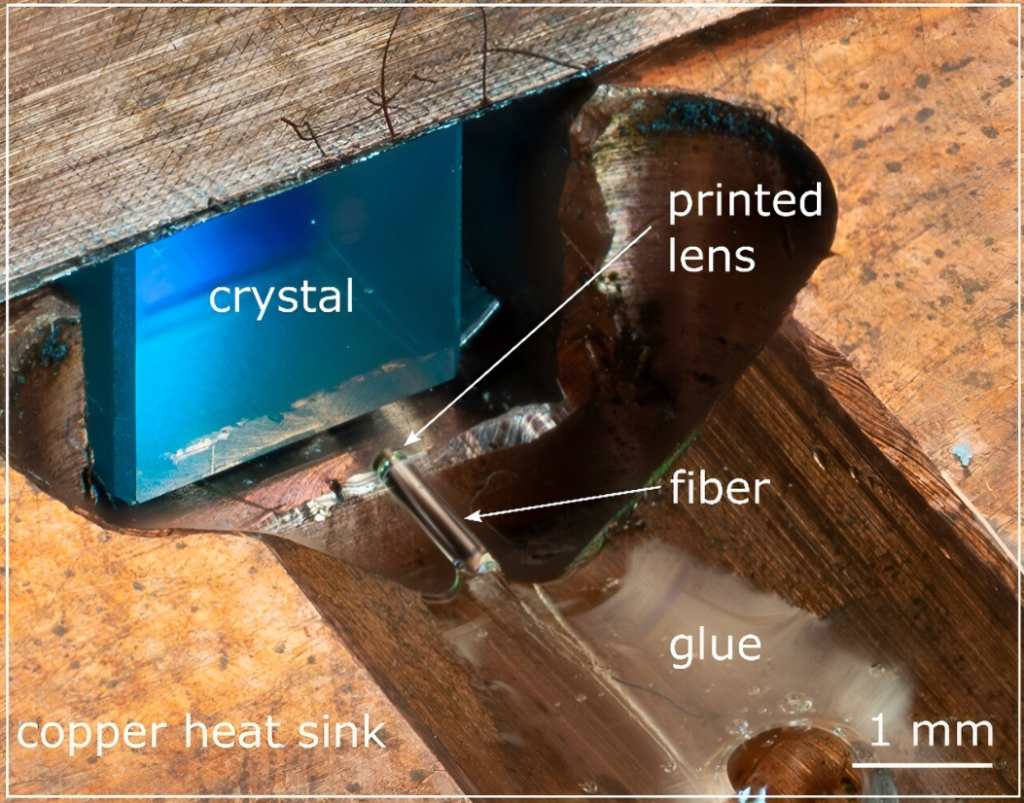Researchers at the 4th Physics Institute at the University of Stuttgart have demonstrated the viability of 3D printed polymer-based micro-optics in a demanding laser environment.
Detailed in the Optics Journal, the study outlines the use of 3D printing technology to directly manufacture microscale optics onto optical fibers, seamlessly integrating fibers and laser crystals into a single laser oscillator. Maintaining stability, the resulting hybrid laser produces a consistent output exceeding 20 mW at 1063.4 nm, reaching a peak of 37 mW. What sets this laser apart is its combination of the compactness, durability, and cost-effectiveness of fiber-based lasers along with the versatile properties of crystal-based solid-state lasers, including various powers and colors. This research represents a significant advancement towards creating affordable, small, and reliable lasers, particularly beneficial for lidar systems in autonomous vehicles.
“We significantly reduced the size of a laser by using 3D printing to fabricate high-quality micro-optics directly on glass fibers used inside of lasers,” said research team leader Simon Angstenberger, 4th Physics Institute at the University of Stuttgart. “This is the first implementation of such 3D printed optics in a real-world laser, highlighting their high damage threshold and stability.”

From bulky lasers to compact powerhouses with 3D printed optics
The 4th Physics Institute at the University of Stuttgart has been actively involved in advancing 3D printed micro-optics, particularly in the area of printing directly onto fibers. Using the two-photon polymerization 3D printing approach, the researchers achieved the creation of miniaturized optics with high precision and introduced novel functionalities such as free-form optics and complex lens systems.
In this study, a Nanoscribe 3D printer was used to create lenses measuring 0.25 mm in diameter and 80 microns in height directly onto a fiber of matching dimensions through two-photon polymerization. The procedure included designing an optical element using commercial software, inserting the fiber into the 3D printer, and executing the printing of the complex structure onto the fiber’s end. Precision in aligning the printing with the fiber and ensuring accuracy in the printing process were crucial aspects of this meticulous procedure.
After printing, the researchers assembled the laser and its cavity, opting for fibers instead of traditional mirrors. This approach resulted in a hybrid fiber-crystal laser, with the printed lenses focusing and collecting light into and out of the laser crystal. The fibers were then secured in a mount to enhance system stability and reduce susceptibility to air turbulence, resulting in a compact 5 x 5 cm2 laser system.
Over several hours, the laser power underwent continuous monitoring, confirming that the printed optics exhibited no deterioration and did not adversely affect the long-term properties of the laser. Scanning electron microscopy images of the optics post-use in the laser cavity revealed no visible damage. The researchers are currently focusing on optimizing the efficiency of the printed optics, exploring larger fibers and different lens designs to enhance output power and customization options for specific applications.
“Until now, 3D printed optics have primarily been used for low-power applications such as endoscopy,” said Angstenberger. “The ability to use them with high-power applications could be useful for lithography and laser marking, for example. We showed that these 3D micro-optics printed onto fibers can be used to focus large amounts of light down to a single point, which could be useful for medical applications such as precisely destroying cancerous tissue.”

Advancements in laser technology
In an interview with 3D Printing Industry, Head of L-PBF at Fraunhofer IAPT, Philipp Kohlwes, shared insights into the institute’s beam shaping research for enhancing stability and productivity in metal 3D printing. The research focused on adapting laser profiles to optimize meltpool energy input in laser powder bed fusion (LPBF), addressing issues caused by traditional Gaussian profiles. Essential for laser profile adjustment, beam shaping ensures a uniform temperature distribution. The technology yields advantages like enhanced microstructure control, potential cost savings, and up to 2.5 times faster printing, contributing to increased productivity.
Last year in January, 3DM Digital Manufacturing unveiled a technology enabling users to customize their Selective Laser Sintering (SLS) 3D printing laser for specific materials or applications. Using Quantum Cascade Lasers, the company’s proprietary laser offers adjustable wavelengths, faster laser absorption, and high surface finish. With applications in polymer manufacturing, the scalable technology aims to expand industrial 3D printing’s market share.
Read all the 3D Printing Industry coverage from Formnext 2023.
What does the future of 3D printing for the next ten years hold?
What engineering challenges will need to be tackled in the additive manufacturing sector in the coming decade?
To stay up to date with the latest 3D printing news, don’t forget to subscribe to the 3D Printing Industry newsletter or follow us on Twitter, or like our page on Facebook.
While you’re here, why not subscribe to our Youtube channel? Featuring discussion, debriefs, video shorts, and webinar replays.
Are you looking for a job in the additive manufacturing industry? Visit 3D Printing Jobs for a selection of roles in the industry.
Featured image shows researchers printed microscale lenses directly onto optical fibers, allowing them to compactly combine fibers and laser crystals inside a single laser oscillator. Photo via Moritz Floess and Simon Angstenberger, 4th Physics Institute at University of Stuttgart in Germany.



